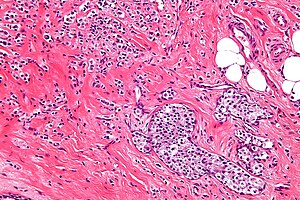Difference between revisions of "Invasive lobular carcinoma"
Jump to navigation
Jump to search
(→IHC) |
|||
| (One intermediate revision by the same user not shown) | |||
| Line 9: | Line 9: | ||
| LMDDx = [[invasive ductal carcinoma of the breast]] with lobular features, poorly differentiated carcinoma, [[LCIS]] | | LMDDx = [[invasive ductal carcinoma of the breast]] with lobular features, poorly differentiated carcinoma, [[LCIS]] | ||
| Stains = | | Stains = | ||
| IHC = E-cadherin -ve, usu. ER and PR +ve, HER2 -ve, CK7 +ve | | IHC = [[E-cadherin]] -ve, usu. ER and PR +ve, HER2 -ve, [[CK7]] +ve | ||
| EM = | | EM = | ||
| Molecular = | | Molecular = | ||
| Line 82: | Line 82: | ||
==IHC== | ==IHC== | ||
Features: | Features: | ||
*E-cadherin -ve. | *[[E-cadherin]] -ve. | ||
*ER and PR +ve. | *ER and PR +ve. | ||
*HER2 -ve. | *HER2 -ve. | ||
| Line 89: | Line 89: | ||
Others: | Others: | ||
*CK20 -ve. | *CK20 -ve. | ||
*Beta-catenin -ve/+ve (~46% completely negative<ref name=pmid11237489>{{cite journal |authors=Karayiannakis AJ, Nakopoulou L, Gakiopoulou H, Keramopoulos A, Davaris PS, Pignatelli M |title=Expression patterns of beta-catenin in in situ and invasive breast cancer |journal=Eur J Surg Oncol |volume=27 |issue=1 |pages=31–6 |date=February 2001 |pmid=11237489 |doi=10.1053/ejso.1999.1017 |url=}}</ref>). | |||
==See also== | ==See also== | ||
Latest revision as of 19:26, 20 December 2021
| Invasive lobular carcinoma | |
|---|---|
| Diagnosis in short | |
 Lobular carcinoma. H&E stain. | |
| LM DDx | invasive ductal carcinoma of the breast with lobular features, poorly differentiated carcinoma, LCIS |
| IHC | E-cadherin -ve, usu. ER and PR +ve, HER2 -ve, CK7 +ve |
| Grossing notes | breast grossing |
| Staging | breast cancer staging |
| Site | breast - see invasive breast cancer |
|
| |
| Syndromes | hereditary diffuse gastric cancer |
|
| |
| Prevalence | relatively common |
| Clin. DDx | other breast tumours |
Invasive lobular carcinoma, abbreviated ILC, is the second most common form of Invasive breast cancer.
It may be referred to as lobular carcinoma; however, this may lead to confusion with lobular carcinoma in situ.
General
Microscopic
Features:
- "Single file" - cell line-up in a row.
- Cell should not be cohesive -- lymphoma should briefly come to mind.
- primary lymphoma of the breast exists... but it is extremely rare.
- Cell should not be cohesive -- lymphoma should briefly come to mind.
- NO gland formation.
- If it forms glands... it is more likely NST.
- May have signet ring morphology.
- NO desmoplastic reaction, i.e. the stroma surrounding the tumour cells should look benign and undisturbed.
Note:
- Commonly have low grade nuclear features.
DDx:
- Invasive ductal carcinoma of the breast with lobular features.
- Poorly differentiated carcinoma.
- LCIS.
- Malignant melanoma.
Subclassification
- Classic lobular carcinoma.
- Low nuclear grade - NO significant variation of nucleus size.
- Pleomorphic lobular carcinoma.
- Significant nuclear atypia.
Note:
- Some pathologist grade lobular carcinoma like other types and avoid the term "pleomorphic lobular carcinoma."[3]
Other variants:
- Histiocytoid.[4]
Images
IHC
Features:
- E-cadherin -ve.
- ER and PR +ve.
- HER2 -ve.
- CK7 +ve.
Others:
- CK20 -ve.
- Beta-catenin -ve/+ve (~46% completely negative[5]).
See also
References
- ↑ URL: http://www.asco.org/ascov2/Meetings/Abstracts?&vmview=abst_detail_view&confID=65&abstractID=33006. Accessed on: 19 April 2011.
- ↑ Online 'Mendelian Inheritance in Man' (OMIM) 192090
- ↑ MUA. Jan 22, 2009.
- ↑ Tan, PH.; Harada, O.; Thike, AA.; Tse, GM. (Aug 2011). "Histiocytoid breast carcinoma: an enigmatic lobular entity.". J Clin Pathol 64 (8): 654-9. doi:10.1136/jcp.2011.088930. PMID 21398688.
- ↑ Karayiannakis AJ, Nakopoulou L, Gakiopoulou H, Keramopoulos A, Davaris PS, Pignatelli M (February 2001). "Expression patterns of beta-catenin in in situ and invasive breast cancer". Eur J Surg Oncol 27 (1): 31–6. doi:10.1053/ejso.1999.1017. PMID 11237489.



